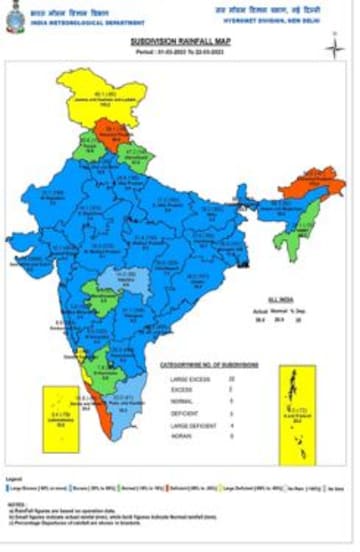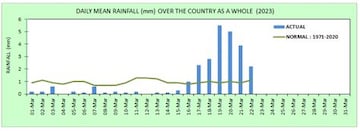India has faced unexpected heavy rains, thunderstorm and hailstorm in the past few weeks causing devastating damages to crops and many agricultural commodities nationwide.
While heavy rains over parts of India have wreaked havoc on rabi crops, especially ready-to-harvest wheat, gram and mustard crops, the rural economy – specially farmers felt the jitters due to a lack of storage facilities for harvested crops that were submerged under water due to the heavy pouring.
The sudden change in weather conditions will probably act as a catalyst to the already high food prices, and may cause supply disruptions in the coming months as farmers bear huge losses due to the destruction of crops.
Indeed, food prices, which account for nearly 40 percent of the CPI basket, skyrocketed in the first half of 2022 before cooling-off in the end of last year but since then it has been rising again and is currently hovering just under 6 percent.
“Inflation is expected to moderate next fiscal, helped by a reduction in fuel and core inflation. Food – a big mover of overall inflation – faces risks from weather disruptions and abnormal monsoons,” says CRISIL analysts in a research note.
“The easing of commodity prices from the highs seen last year will nevertheless offer comfort to fuel and core inflation. Producers, meanwhile, continue to pass on higher costs to retail prices. While goods inflation has already risen sharply, services inflation is gradually catching up as well."

Source: Trading Economics
Rural Economy To Face Tougher Challenges?
The rural India, which is largely dependent on agricultural income has been growing modestly on high agri prices so far but climate risk from heatwaves and an expected El Nino condition could put some pressure on the output.
Along with that, higher borrowing costs, which usually impacts everyone dependent on bank loans, could make farmers’ lives much more difficult than it already is.
The repo rate at 6.5 percent, is already above the RBI’s top tolerance band and the central bank will probably keep tightening its policy in order to tame price pressures. That could have an adverse effect on the economic growth and impact common man’s lives.
‘Rising borrowing costs will be the key challenge next fiscal, which is likely to moderate domestic demand, going ahead. We are already seeing signs of a slowdown in demand for goods, even as demand for contact-based services continues to rise,” adds CRISIL analysts.

Source: IMD
The Weather Outlook
India’s monsoon patterns are always different. Last year it was declared as normal monsoon which was better than the long-term average. This year heat waves from East Asia, Afghanistan and Pakistan will decide the climate pattern like EI Nino or EL Nina in the overall region.
During EI Nino, heat waves tend to get trapped more in North, West and Central India whereas El Nina observed deeper in the southern region.
Raghu Murtugudde, Visiting Professor, Earth System Scientist at IIT Bombay, says that if EI Nino happens in the summer after La Nina in winter which would be create most deficit pattern in the monsoon and expecting 15% deficit compared to long term averages rainfall.
Murtugudde further added that Western Ghats could see untimely rainfall before monsoon on the back of EI Nino effect. The current data pattern and forecasting models indicate EI- Nino effect on monsoon deficit is most likely to happen across India.

Source: IMD
According to a weather forecast report from the India Meteorological Department, the probability of a precipitation for February–April period indicates that an enhanced probability of below normal precipitation is likely over most parts of northwest, north along the plains of Himalayas, central and east India and some parts of northeast of South Asia and above normal precipitation is likely over some parts of west, south peninsula and few parts of northeast and southeast of South Asia.
The report also says the average monthly temperature during April is likely to be normal to below normal for all south Asian countries after April.
All in all, abundance or lack of rainfall will decide price increases on food and in turn over all inflation in India in the coming months. Conditions over the Pacific and the Indian Oceans will have a strong influence on Indian monsoon. A harsh season of intense heatwaves and soaring temperatures could be awaiting in the coming months.
(Edited by : C H Unnikrishnan)
First Published: Mar 24, 2023 12:29 PM IST


 Source: Trading Economics
Source: Trading Economics Source: IMD
Source: IMD Source: IMD
Source: IMD
